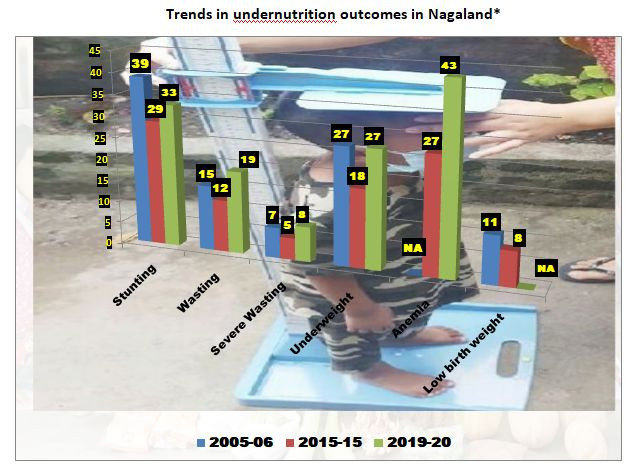*In percentages among children below 5 years of age #NA: Data not available Source: State Nutrition Profile: Nagaland, NITI Aayog

Stunting, wasting, underweight increasing among children while obesity among men maintains continued upward trend, highlights NITI Aayog’s Data Note
Morung Express News
Dimapur | October 24
In a snapshot reflecting declining nutritional status of children in Nagaland, a recent policy paper by the NITI Aayog has highlighted that prevalence of stunting, wasting and underweight among children increased in Nagaland from 2016 and 2020.
Overweight/obesity among men also maintained an upward trend since 2016, informed the “State Nutrition Profile: Nagaland,” a Data Note (policy paper) by prepared by NITI Aayog in association with the UNICEF, International Food Policy Research Institute (IFPRI), Indian Institute of Population Sciences (IIPS), and the Institute of Economic Growth (IEG). It was published in September, 2021.
The Data Note describing trends for a set of key nutrition and health outcomes, determinants, coverage of interventions are based on data the National Family Health Survey (NFHS) 3 (2005-06), 4 (2015-2016), and 5 (2019 2020), stated the NITI Aayog, the public policy think tank of the Government of India.
In addition to standard prevalence analyses, it includes headcount-based analyses aligned to the Poshan Abhiyaan monitoring framework and monitoring and uses data from NFHS- 5 to provide evidence that helps identify priority districts in the State with the public health concern as per the WHO guidelines, it said.
Key Takeaways: Declining nutritional status
Stunting: As per the Data Note, while prevalence of stunting in Nagaland declined by 10 percentage points (pp) from 2006 to 2016, it increased by 4 pp in 2020.
According to the UNICEF, stunting is defined as the percentage of children, aged 0 to 59 months (<5 years), whose height for age is below minus two standard deviations from the median of the WHO Child Growth Standards.
A stunted child is too short for their age, does not fully develop and stunting reflects chronic undernutrition during the most critical periods of growth and development in early life, it said.
As per the Data Note, while stunting among children declined from 39% to 29% from 2006 to 2016, it increased to 33% in 2020.
Accordingly, out of 1,56,950 children in the below 5 years category, 50,883 were estimated to be stunted.
All the 11 districts assessed in Nagaland were slotted as ‘districts with public health concern’ with highest cases in Dimapur (6,928) followed by Kohima (5,274) and Tuensang (4,808).
Wasting: It declined by 3pp from 15% to 12% during the 2006 and 2016 period, but the progresses were reversed and it increased by 7pp to 19% in 2020.
Prevalence of wasting was observed in 29892 children (below 5 years), out of which 12,322 cases of severe were wasting, the Data Note highlighted.
Wasting among children was highest in Dimapur at 6,928, followed by Kohima (5,274) and Tuensang (4,808). 9 out of 11 assessed were designated as ‘districts with public health concern’ for both wasting and severe wasting.
According to WHO, wasting is defined as low weight-for-height and often indicates recent and severe weight loss and usually occurs when a person has not had food of adequate quality and quantity and/or they have had frequent or prolonged illnesses.
Underweight: As the case with stunting and wasting, cases of underweight children which declined by 9pp from 2006 to 2016, also increased by 9pp from 2016 to 2020.
Consequently, after falling 27% in 2006 to 18% in 2016, it reverted back to 27% in 2020. A total of 41,866 of children out of 1,56,950 were considered to be underweight in 2020.
Underweight is defined as low weight-for-age by WHO and child who is underweight may be stunted, wasted or both. 10 out of 11 were termed as ‘districts with public health concern’ for both underweight children.
In a positive note however, underweight among women (15-49 years) declined from 17% in 2016 to 12% in 2016 and further to 11% in 2020.
Anemia: Meanwhile, cases of Anemia, describing the “percentage of children aged 6−59 months with a haemoglobin concentration less than 110 g/L, adjusted for altitude” saw the biggest increase by 16pp from 27% in 2016 to 43% in 2020.
A total of 60,187 children were estimated to be anemic, with 6 out of 11 designated as ‘districts with public health concern’.
According to WHO, anemia is associated with poor cognitive and motor development, and work capacity.
Anemia among non-pregnant women increased by 1pp from 2016 to 2020 while it declined by 11pp from 2016 to 2020 in pregnant women. However, no districts were considered as a public health concern in case of Anemia among non-pregnant women while 1 was designated so in case of pregnant women.
Trends in overweight/ obesity & NCDs
Meanwhile, cases of overweight/obesity among men (15-54 years) increased by 8pp from 2006 to 2016 and continued to increase by 10pp from 2016 to 2020, the Data note highlighted.
For instance, while just 6% men were considered overweight/obesity in 2006, it increased to 14 in 2016 and to 24% in 2020.
Among women (15-49 years), it decreased from 16% in 2016 to 14% in 2020 or 2 pp.
In terms of Non-communicable diseases (NCDs), it highlighted that percentage of men with high blood pressure remained the same at 28% in 2016 and 2020 while those with high blood sugar declined marginally from 10% to 8% during the same period.
In the same period, cases of blood pressure increased from 18% to 21% among women, while high blood sugar declined marginally from 7% to 5%.






